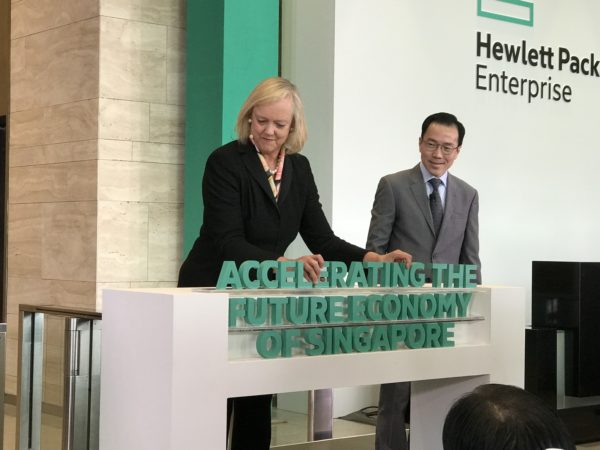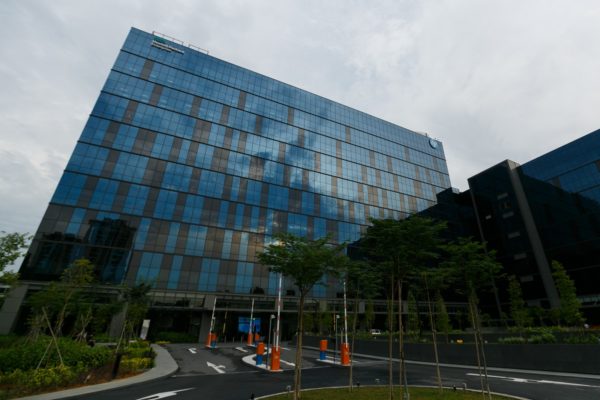
Hewlett-Packard Enterprise (HPE) is investing US$140 million over the next five years in a new regional headquarter and innovation programme which includes helping Singapore startups globalise.
The innovation programme called InnovateNext will enable startups and its customers to create and develop new ideas to drive their businesses, HPE chief executive Meg Whitman said today at its opening in Singapore.
The American tech giant is collaborating with the Economic Development Board on this programme. In a media briefing, Whitman said that innovation is important because “the entrepreneur is inventing everything.”
So in addition to organic innovation, HPE wants to co-create with its customers and help startups develop and commercialise new solutions and technologies.
The innovation programme will focus on developing new technologies for the public sector and various industries. These include manufacturing, distribution, financial services and communications, media and entertainment.
Of the US$140 million, US$16 million will be spent to develop 12 Singapore tech startups.
HPE’s domain experts, marketers and researchers will chip in to support the startups. The partnership is strategic – HPE’s products will be strengthened while the startups will find customers here and globally.
Over the next three years, the company also aims to co-innovate and develop with its enterprise customers, 10 vertical solutions that are aligned to HPE’s technology roadmap in hybrid IT, Internet of Things, data and analytics and which can be marketed globally.
Whitman was here to open HPE’s new Asia-Pacific and Japan office. Built by Mapletree, the new 11-storey building at Depot Close brings together all of HPE’s marketing, research and development, regional sales operations and other staff. Currently, its HPE’s server manufacturing facility remains in Alexandra Close.
HPE chose Singapore as a regional headquarters, Whitman said, because it is in the centre of the Asia-Pacific region, the company’s fastest growth area.
“We’ve been in Singapore for many years. The country is centrally located, it has a stable government, and is friendly to businesses. Sales operations and headquarter teams in finance, human resource are all done out in Singapore.”

While the company had a rough first quarter for fiscal 2017 where profits were flat and key product lines registered declines, the coming months will be about growth.
HPE shrank when several businesses were spun out, Whitman explained. In 2015, the PC and printer business was spun out to form HP Inc.
Last year, it spun out its non-core software assets to form Micro Focus. Enterprise services were also spun out to form DXC. Managers and business leaders in the regions and countries were involved in these activities and were less focussed on business growth.
Thinner and leaner now and with its laser-sharp focus on hybrid IT, Internet of Things and services, Whitman believed the company is ready to accelerate growth.
HPE has also been busy on the acquisition trail, snapping up four companies since the start of this year, They are Nimble Storage, SimpliVity, Niara and Cloud Cruiser, all of which strengthened its core product offerings in hybrid IT, security, data and analytics and Internet of Things.
More acquisitions can be expected, said Whitman.
Singling out smart cities as an area of growth, she said: “Cities around the globe are trying to modernise their infrastructure and their services for their employees and citizens.”
“Each city is figuring out how to digitise the many services. HPE aims to provide the infrastructure to make the digitisation of services in cities happen,” she added.
Hewlett-Packard was one of the earliest multinational corporations in Singapore. It used to hire thousands of workers for its factories here. In 1970, it opened its first facility, a flatted factory to make core memories for its HP 211X computers.
It went on to make other hardware products including printers and printer inks, calculators, solid state displays and keyboards. In its 47 years here, the company trained several generations of engineers and managers many of whom hold prominent positions in other tech companies as well as government. This is a key reason why in the opening of the new building in Depot Close, HPE involved its alumni.
As one industry observer said: “Throw a stone and you’re likely to hit an HP alum.”
Before Google made corporate cafeterias cool and trendy, HP built a cafeteria in its building in Depot Road, not far from the new building in Depot Close.
It was supervised by an in-house chef who cooked up local food especially Penang delicacies, Western meals as well as pastries. With its floor-to-ceiling glass walls, the cafe overlooked a garden and became the benchmark for companies wanting to build their own corporate cafeterias.
There were about 6,000 to 7,000 employees in HP before the split in 2015 into HPE and HP Inc.
Grace Chng is a veteran tech writer.






